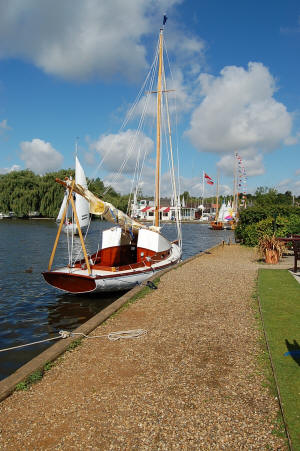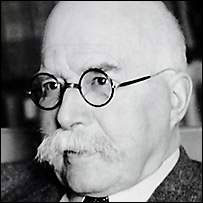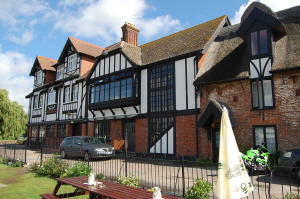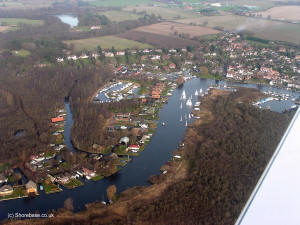Horning
Horning lies on a bend of the River Bure
- just downstream from
Wroxham. In fact, its name is
derived from the Old English for people ('ingas') of the
bend ('horna'). The village provides the epi-centre for both of Arthur
Ransome's classic children's adventure stories Coot
Club (1934) and The Big Six (1940).

Horning Staithe

Arthur Ransome
At the beginning of The Big Six the Death
and Glory is moored at Horning Staithe and the inn
mentioned is The Swan - which is still
there today.
|
|
'The staithe? Everyone knows the staithe, where boats tie
up when calling at Horning. Everyone knows the inn at
the bend of the river above it, and the boatbuilders'
sheds below it, and the bit of grass beside it, and the
pump by the old brick wall, and the road with the shops
on the further side of it. The staithe is the centre of
that riverside world.' |
|

The Swan Inn, Horning |
|
In the story, Bill, Peter, Joe and Tom Dudgeon (the
Horning doctor's son) are accused of setting boats
adrift from the staithe, but they soon set out to
discover the real criminals.
In Coot Club Dick
and Dorothea travel by motor launch from Wroxham to
Horning with Mrs Barrable. They are in the Norfolk
Broads for a holiday and are going to stay on Mrs
Barrable's boat the Teasel - which is moored at
Horning.
|
'On and on they went down the river. They were coming now
to another village. The launch slowed up. They were
passing wooden bungalows and a row of houseboats. The
river bent sharply round a corner. There was an old inn
at the bend, the Swan. Then there was a staithe with a
couple of yachts tied up to it. Beyond the staithe were
big boat-sheds, like those they had seen at Wroxham.
"This is Horning," said Mrs Barrable.' |
|
Once they arrive in Horning the Ds become embroiled with
Tom Dudgeon and other members of the Coot Club and
embark on a long journey through the Norfolk Broads to
avoid the Hullabaloos in the Margoletta who are
chasing Tom because he set their boat adrift. However,
Tom only did this to protect a coot's nest when the
Hullabaloos refused to move.
|
|

Horning from the Air |
Another visitor to Horning was Hugh Money-Coutts who, in
1919, published a verse account of a journey through the
Broads. Here is an interesting passage about the
village:
|
Ere dusk, Ted moored the ship by Horning Ferry;
They ate their meat; dim craft beyond the wherry
Beguiled the starry night with cheerful noise
And happy laughter; from astern the boys
Cast loose the dinghy, clattering all the gear,
And lightly argued who should row, who steer,
Which way to set their course, upstream or down,
And where the ferry lay, and where the town. |
There is also an anonymous rhyme which features Horning
and it serves to illustrate how the North Sea poses a
constant threat to the Broads' unique eco-system:
|
When the sea comes
in at Horsey Gap
Without any previous warning,
A swan shall build its rushy nest
On the roof of the Swan at Horning.
And a bald headed crow, contented and merry,
Shall feast on the corpses that float by the ferry. |
See also The Broads and
Wroxham. |
Links:
More photographs of Horning
|

